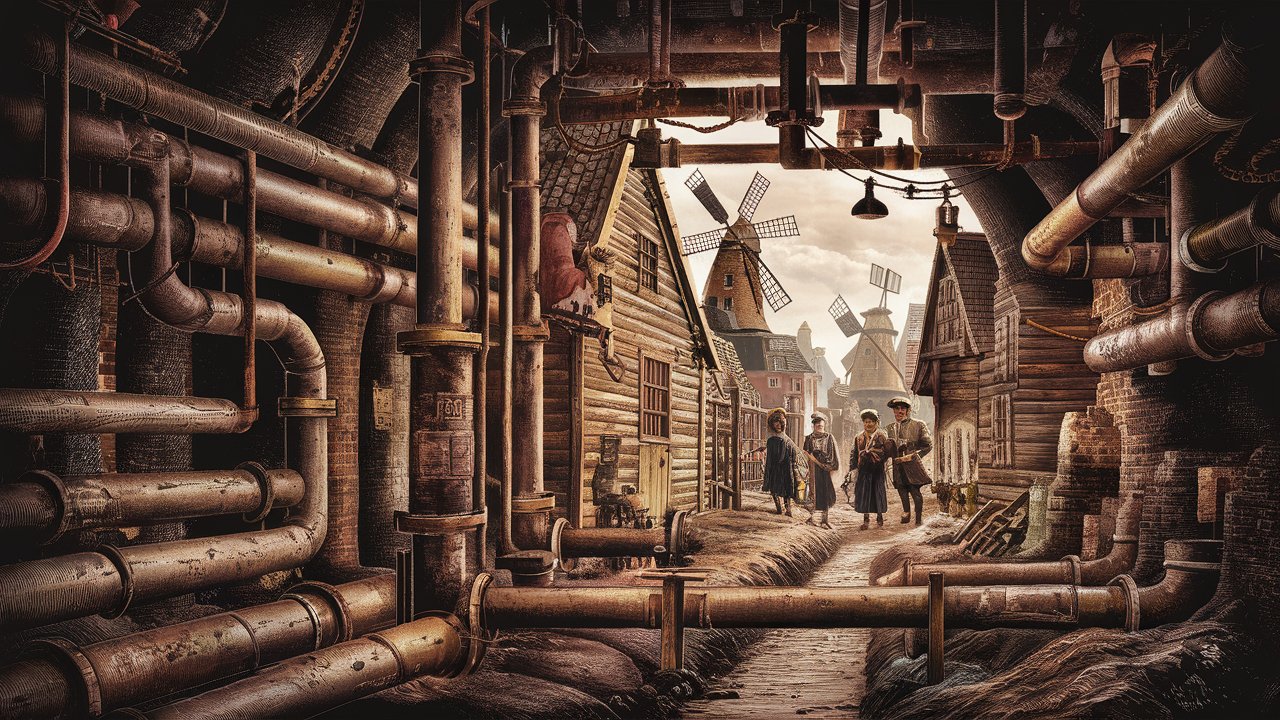While the origins of plumbing can be traced back to ancient civilizations like Rome, New York City’s plumbing history is a unique tale of rapid urban development and innovative solutions. The city’s journey from rudimentary sewage channels to a complex network of gas, water, and sewer systems mirrors its growth from a small Dutch settlement to a global metropolis. This evolution encompasses the implementation of cast-iron pipes for gas lighting, the construction of the revolutionary Croton Aqueduct for water supply, and the development of an extensive sewer system to combat public health crises.
New York’s plumbing infrastructure has continuously adapted to meet the needs of its growing population, from the first underground sewers in the Dutch colonial era to the modern-day green infrastructure initiatives. This history reflects not only technological advancements but also the city’s ongoing struggle to provide clean water, effective waste management, and reliable utility services to millions of residents. The story of New York City’s plumbing is one of engineering feats, public health challenges, and urban planning triumphs that have shaped the very foundation of the city we know today.
1660s – First Underground Sewer System Gets Built During New York’s Dutch Colonial Era
In the 1660s, New York City, then known as New Amsterdam, made a significant leap in urban sanitation with the construction of its first underground sewer system. This rudimentary yet innovative system was built in just one day during the Dutch colonial era. Workers dug a channel in the middle of Broad Street, which was fed by gutters throughout the city. The channel was then decked over with wood, creating an enclosed sewer system. This early infrastructure project laid the groundwork for the city’s future development and demonstrated the Dutch settlers’ practical approach to urban planning and sanitation.
1677 – First Public Well Gets Built
In 1677, New York City marked another milestone in its water infrastructure with the construction of the first public well at Bowling Green. However, this solution proved to be less than ideal. The well water tended to be brackish due to seawater seeping into the groundwater supply. This unreliability led many early European colonists to rely on Collect Pond as an alternative water source. The challenges faced with this first public well highlight the ongoing struggle to provide clean, potable water to the growing city, a challenge that would persist and shape New York’s water supply strategies for centuries to come.
1823 – Cast Iron Pipes Start Getting Laid Under New York City’s Streets
The year 1823 marked a significant advancement in New York City’s utility infrastructure with the introduction of cast iron pipes. The newly incorporated New York Gas Light Company pioneered this development, securing a contract to manufacture and lay cast-iron pipes for gas lighting along Broadway. This project, which stretched from Grand Street to Battery, was completed in 1825. The result was transformative: Broadway became the first street in New York to be fully illuminated by gas lighting. This innovation not only improved urban lighting but also set the stage for the widespread use of underground piping systems for various utilities throughout the city.
1832 – Cholera Epidemic Caused By Contaminated Water Kills 3,515 People
The year 1832 brought a devastating cholera epidemic to New York City, starkly highlighting the critical need for improved sanitation and clean water supply. The outbreak, fueled by contaminated water and exacerbated by the lack of proper sewers and garbage collection, rapidly spiraled out of control. By the time it subsided, the epidemic had claimed 3,515 lives out of a population of 250,000 – a staggering toll equivalent to over 100,000 deaths in today’s city of eight million. This tragedy underscored the urgent necessity for comprehensive improvements in the city’s water and sanitation infrastructure, catalyzing future public health initiatives and urban planning reforms.
1835 – Great Fire of New York
The Great Fire of New York in 1835 was a catastrophic event that exposed critical weaknesses in the city’s infrastructure, particularly its water supply system. As one of three major fires that caused extensive damage to New York City, this disaster made it painfully clear that the rapidly growing metropolis needed a more robust and reliable water supply to meet both everyday needs and emergency situations. The aftermath of the Great Fire became a turning point, spurring city officials and planners to seriously consider and implement major improvements to New York’s water infrastructure, setting the stage for significant developments in the years to come.
1842 – Croton Aqueduct Gets Completed
The completion of the Croton Aqueduct in 1842 marked a monumental achievement in New York City’s water supply history. On June 22, 1842, water began its 41-mile journey from the Croton River to lower Manhattan, taking 22 hours to reach its destination through the force of gravity alone. The official opening on October 14, 1842, was a cause for citywide celebration, with even President John Tyler attending the festivities in City Hall Park. This engineering marvel not only provided New York with a reliable source of clean water but also laid the foundation for the city’s future growth and development, significantly improving public health and fire-fighting capabilities.
1849 – NYC Sewer System Construction Begins
In 1849, New York City embarked on a crucial infrastructure project: the systematic construction of its sewer system. This initiative came after years of haphazard planning and in direct response to a series of deadly cholera outbreaks. Between 1850 and 1855, the city laid an impressive 70 miles of sewers, expanding the network throughout the metropolis in the latter half of the 19th century. Concurrently, Brooklyn began constructing its own sewer system, also motivated by devastating cholera outbreaks. These projects were vital as outhouses became less common, necessitating more effective methods to remove harmful human waste and ensure clean drinking water, especially as waterborne diseases continued to threaten public health.
1886 – NYC Starts Treating Wastewater At The Coney Island Facility
The year 1886 marked a significant milestone in New York City’s approach to wastewater management with the inauguration of the first wastewater treatment facility at Coney Island, Brooklyn. This pioneering effort was soon followed by the construction of two additional facilities: the 26th Ward in Brooklyn (1894) and Jamaica in Queens (1903). Strategically placed near NYC’s public beaches, these facilities employed basic processes to treat wastewater and control water pollution. This development represented a crucial step forward in the city’s ongoing efforts to improve public health and environmental quality, laying the groundwork for the comprehensive wastewater treatment system that would evolve over the following decades.
1902 – Most Of The New York City Gets Indoor Plumbing
By 1902, New York City had achieved a remarkable feat in urban infrastructure: the majority of the city, including a large percentage of tenement houses, had been equipped with sewage service. This development marked a significant improvement in sanitation and quality of life for New Yorkers across social classes. The scale of this achievement is evident in the modern NYC sewer system, which now encompasses an astounding 6,600 miles of pipes and mains – a network so extensive that if laid end to end, it would stretch from New York to Alaska and back. This comprehensive sewage system has been instrumental in supporting the city’s growth and maintaining public health over the past century.
1905 – NYC Board of Water Supply Gets Founded
The year 1905 saw a pivotal development in New York City’s water management with the establishment of the NYC Board of Water Supply (BWS). Created by the New York State legislature through the Water Supply Act of 1905, the BWS was empowered to develop water supply facilities in the Catskills region. This act also mandated the City to allow local communities to connect to the water supply infrastructure. Concurrently, the State Public Health Law of 1905 granted the City authority to regulate land use in the upstate watershed to protect drinking water and provided eminent domain powers to acquire necessary land. These legislative actions laid the foundation for the expansive and protected water supply system that New York City relies on today.
1972 – Clean Water Act
The Clean Water Act (CWA) of 1972 marked a watershed moment in environmental protection and water quality regulation in the United States, with significant implications for New York City. While its foundations were laid in the 1948 Federal Water Pollution Control Act, the 1972 amendments substantially expanded and reorganized the legislation. The CWA established a comprehensive framework for regulating pollutant discharges into U.S. waters and set quality standards for surface waters. For New York City, this act provided crucial guidelines and regulations for managing its vast water resources, including the Hudson River, East River, and surrounding coastal areas, pushing the city towards more sustainable and environmentally conscious water management practices.
1977 – NYC DEP’s Bureau of Water Supply Gets Founded
In 1977, New York City took a significant step in centralizing its water management with the creation of the Department of Environmental Protection’s (NYC DEP) Bureau of Water Supply. This new entity consolidated the previously separate water supply and wastewater treatment functions of the city government. The NYC DEP’s mission encompasses a broad range of environmental responsibilities, including providing high-quality drinking water, managing wastewater and stormwater, and reducing air, noise, and hazardous materials pollution. This consolidation streamlined the city’s approach to water resource management, enabling more coordinated efforts to protect public health and enhance the urban environment for all New Yorkers.
July 13, 1977 – Power Outage Causes Sewer Pumps To Stop Functioning
The blackout of July 13, 1977, exposed a critical vulnerability in New York City’s wastewater management system. As the power failure caused sewer pumps to cease functioning, the city experienced a massive environmental crisis. An estimated 828 million gallons of contaminated water spilled into the rivers surrounding Manhattan and Brooklyn from eight different treatment plants. This incident highlighted the interdependence of the city’s various infrastructure systems and the potential for cascading failures. It also underscored the urgent need for more resilient and backup systems in critical infrastructure, leading to improvements in emergency preparedness and infrastructure planning in subsequent years.
2010 – New York City Launches Its Green Infrastructure Plan
In September 2010, New York City unveiled its ambitious Green Infrastructure Plan, marking a shift towards more sustainable urban water management. This 20-year initiative aims to improve stormwater management and water quality across the city. Billed as a “sustainable strategy for clean waterways,” the plan set a target of managing 10% of runoff in watersheds with combined sewers. The approach involves creating green spaces that serve as ‘green infrastructure’ for climate adaptation, helping to reduce surface heat and mitigate stormwater flooding. This innovative plan represents New York’s commitment to integrating environmental sustainability with urban development, addressing both current needs and future challenges posed by climate change and urbanization.


